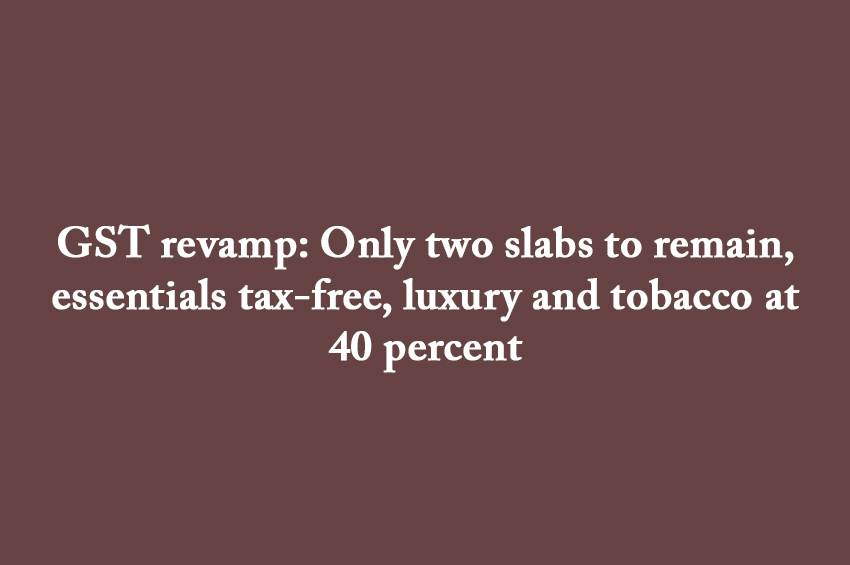Winning Bizness Desk
Mumbai GST Council has approved sweeping changes in the indirect tax structure, reducing the existing four tax slabs to just two, while exempting daily essentials like milk, bread, and health insurance. The changes, seen as the biggest reform since the introduction of GST in 2017, will come into effect from September 22.
The GST Council, chaired by Finance Minister Nirmala Sitharaman, decided in its 56th meeting held in New Delhi on September 3 to collapse the existing four slabs of 5 percent, 12 percent, 18 percent, and 28 percent into two broad categories of 5 percent and 18 percent. However, a new 40 percent rate has been created for luxury items and tobacco products, while several essential goods and services have been exempted completely.
Daily essentials exempted from tax
The council approved a zero percent GST on common food items such as milk, bread, paratha, paneer, and chhena. Health and life insurance policies for individuals will also be tax-free, along with 33 life-saving medicines, particularly those used for cancer and rare diseases. Officials said the aim is to provide relief to households and encourage wider access to health coverage.
Luxury items and tobacco to attract higher tax
Luxury items and tobacco to attract higher tax On the other hand, luxury goods such as large cars, yachts, private jets for personal use, and motorcycles above 350cc will now fall under the 40 percent GST bracket. Tobacco products including cigarettes, gutkha, and pan masala will also be taxed at this higher rate, though their implementation has been delayed until the government clears pending cess dues.
Cheaper hotels and services, expensive events
As part of the reform, hotel room tariffs up to Rs 7,500 per day will now attract only 5 percent GST, down from the earlier 12 percent. Services linked to fitness and grooming such as gyms, salons, barber shops, and yoga centers will also move from 18 percent to 5 percent, making them more affordable for the general public. On the other hand, entry to casinos, race clubs, and sports events like the Indian Premier League (IPL) will be taxed at 40 percent, up from the current 28 percent.
PM Modi welcomes GST reforms
Prime Minister Narendra Modi hailed the decision on social media, saying the reforms will benefit common citizens, farmers, small and medium enterprises, women, and the youth. He said the reduced rates on essentials and services will ease life for the middle class and small businesses, while higher taxes on harmful products will discourage their use. Modi added that the changes are in line with the government’s effort to make business easier and improve people’s quality of life.
Relief for industries, farmers, and housing
The new tax structure is expected to provide significant relief for industries and farmers. Agricultural machinery such as tractors, harvesters, and composting equipment will now attract only 5 percent GST, compared to 12 percent earlier. Fertilizers and pesticides have also become cheaper due to rate cuts. The textile industry will benefit from reduced GST on synthetic fiber and yarn, while renewable energy equipment like solar cookers and wind turbines will also see lower tax rates. For households, cement has been moved from 28 percent to 18 percent, cutting costs of construction and repair. Consumer durables like televisions and air conditioners will also become cheaper.
Expected revenue impact on government
Finance Minister Sitharaman acknowledged that slashing rates on essential goods may impact revenue in the short term. SBI Research estimates the government could lose around Rs 85,000 crore annually due to lower collections. However, Sitharaman stressed that increased consumption, better compliance, and plugging tax leakages will make up for the shortfall over time. The steep 40 percent tax on luxury and sin goods is also expected to boost government earnings.
Tobacco slab delayed until cess dues cleared
The Council decided not to immediately implement the 40 percent GST rate on tobacco products. Currently, tobacco is taxed at 28 percent along with a compensation cess that ranges between 5 percent and 290 percent depending on the product. For example, gutkha attracts a cess of 204 percent, while unprocessed tobacco carries a 71 percent cess. The new 40 percent slab will be notified once all pending compensation cess debts are settled.
Two-slab structure aimed at simplification
According to the Finance Minister, the purpose of GST 2.0 is to simplify the indirect tax system, lower the burden on common citizens, and support small businesses. The Council has also tried to resolve the problem of inverted duty structure, where raw materials attract higher tax than finished products. By rationalizing rates, the government hopes to encourage manufacturing, boost demand, and make compliance easier for businesses. The new two-slab system will formally come into effect from September 22, coinciding with the start of Navratri.
Key highlights in a nutshell:
- GST slabs reduced from four to two – only 5% and 18% remain.
- Essentials like milk, bread, paratha, paneer exempted from GST.
- Individual health and life insurance made completely tax-free.
- Luxury goods and tobacco to attract 40% GST rate.
- Hotel rooms under Rs 7,500 now at 5% GST.
- Salons, gyms, yoga centers to attract only 5% GST.
- IPL tickets, casinos, race clubs taxed at 40%.


